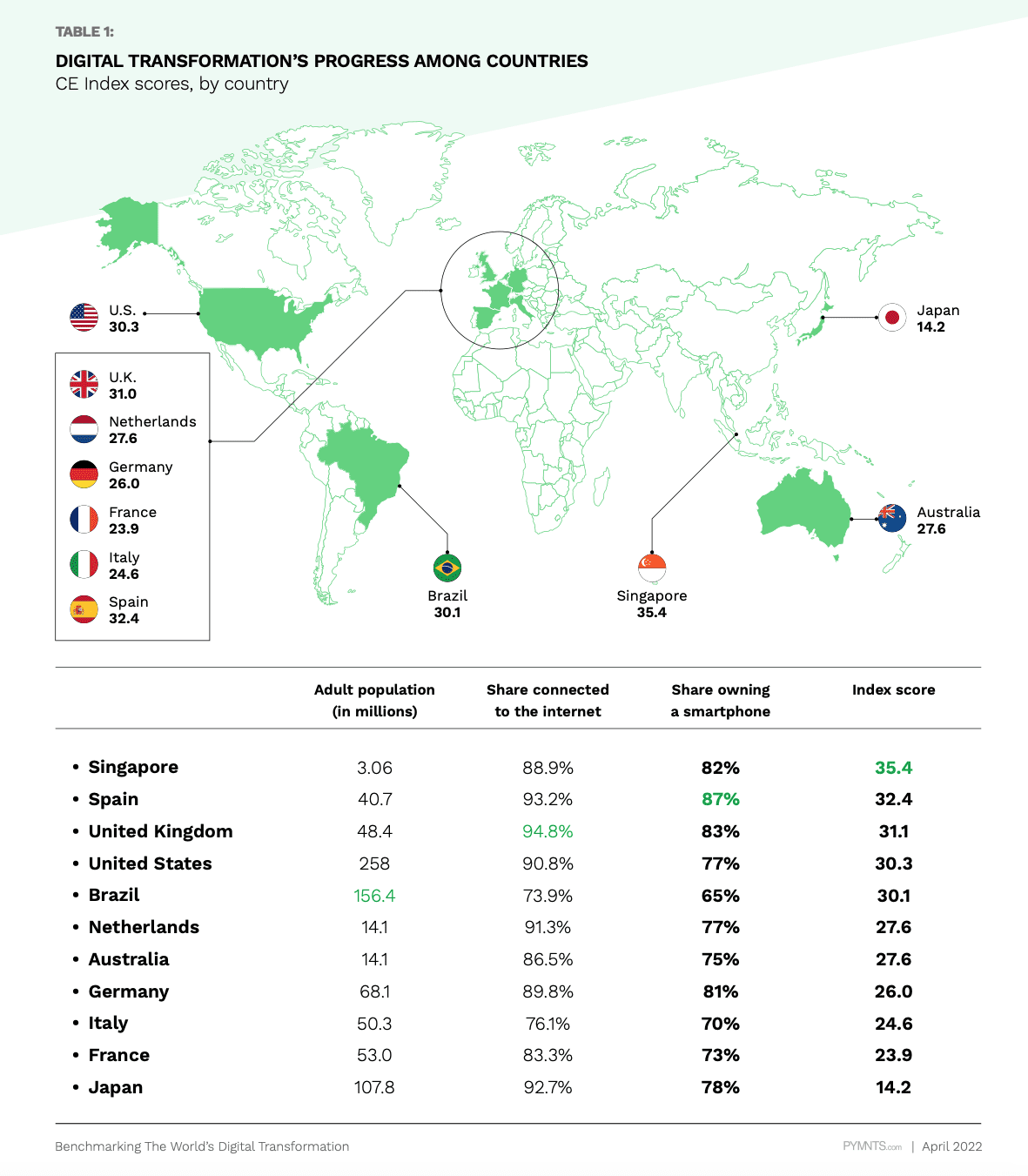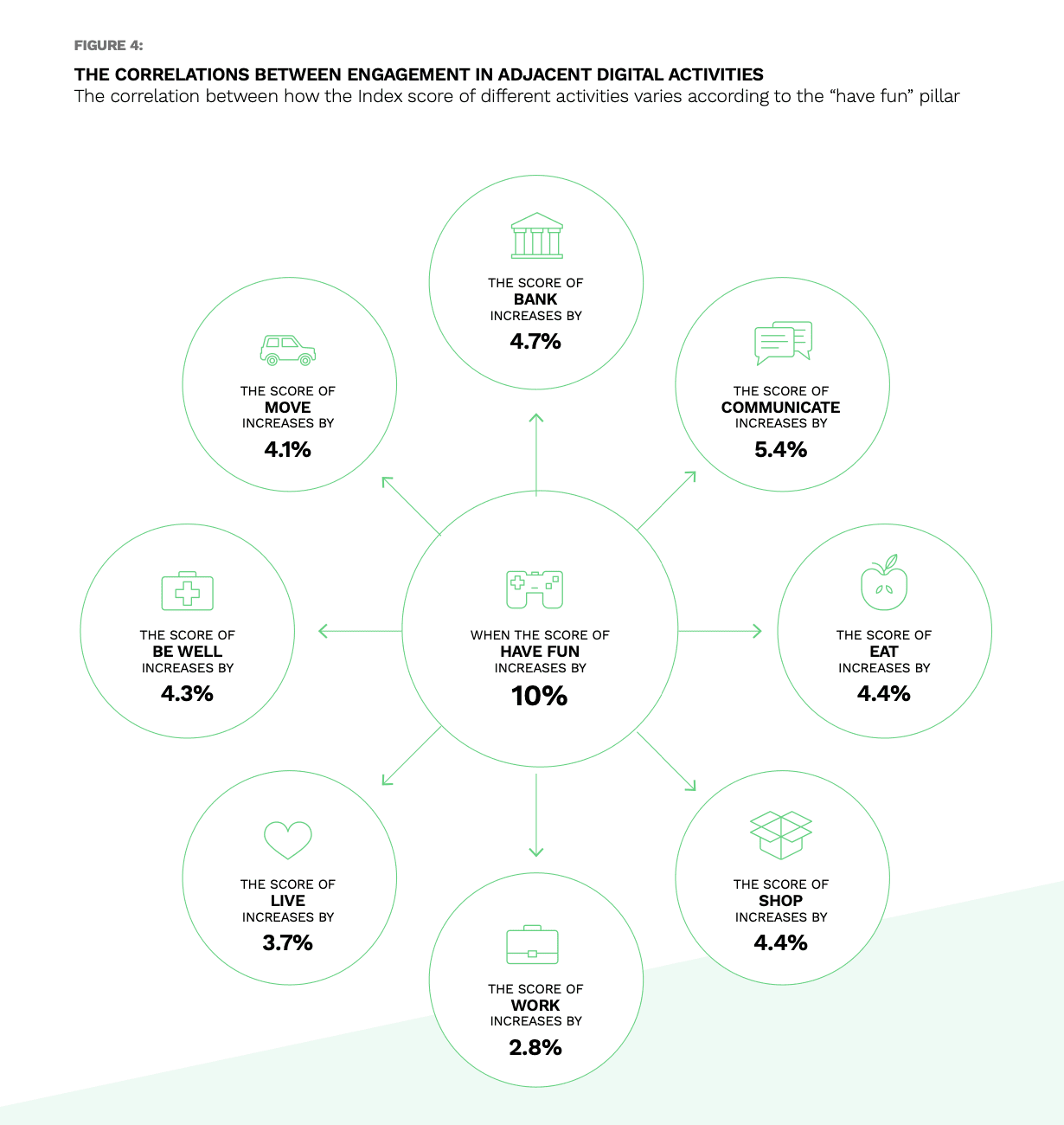
As consumers keep recasting routines and businesses invest hundreds of billions of dollars in new digital systems, the transformation we’ve undertaken is humming — but far from complete.
To measure gains being made and identify new areas of opportunity being created, PYMNTS’ Benchmarking The World’s Digital Transformation, The ConnectedEconomy™ Index Q1 2022, created in collaboration with Stripe, is a groundbreaking study of consumer engagement across 40 key activities and the 10 categories we call “pillars of the connected economy.”
Examining data from more than 15,100 respondents in 11 countries gathered between Jan. 13 and Feb. 16, 2022, we conclude that while these nations generate 50% of the world’s GDP and represent a bloc of 700 million consumers with smartphones and web access, their economies are still very much in the early stages of digital transformation.
Calculating an average CE Index score of 27.1 out of a possible 100 across the 11 nations, we found “these countries collectively are a little more than a quarter of the way to complete digital transformation and a fully connected global economy.”
Looking at engagement as a key metric of the digital shift, it is highest in digital-first activities where tools and solutions are built for the digital economy and not grafted onto legacy methods. For example, 61% and 56% of the populations across the 11 countries studied engage in digital-first activities like streaming entertainment, with 31% and 25% respectively doing so daily.
This is also seen in mobile and online banking, where 59% of consumers across all 11 countries engage. Singapore, Spain and the U.K. are standouts as “availability of attractive mobile banking alternatives to brick-and-mortar banking — coupled with the widespread availability of smartphones — drives both adoption and usage,” and higher CE Index rankings.
Conversely, use of services like telehealth and online grocery subscriptions is seeing double-digital adoption but still lags digital-first alternatives due to strong ties with the physical.

Read the study: Benchmarking The World’s Digital Transformation, The ConnectedEconomy™ Index Q1 2022
Fun, Banking and Communicating Dominate
People gravitate to enjoyment and we find that in the new data, with engagement currently highest in the “have fun” pillar of the Connected Economy and activities related to it.
Overall, 61% respondents in the 11 countries studied “frequently go online to have fun, specifically to stream music and videos,” while 59% use digital banking frequently.
Somewhat surprisingly, communicating via social networks and apps comes in lower at 44%.
Digital demographics are changing too.
Benchmarking The World’s Digital Transformation notes that regions including as Singapore and Spain “see higher levels of digital engagement among all age groups, including baby boomers and seniors,” while in the U.S. and Japan, baby boomers and seniors “are far less engaged digitally in any of the 40 activities than millennials and Gen Z.”
Index scores will be pushed higher as more people engage as each digital activity overlays with another. Such “inherent synergies” act as a powerful driver of engagement and transformation.
We found that for every 10% growth in the number of consumers who use digital channels to engage socially, the CE Index score across these 11 countries could increase by 5.4%.

See: Benchmarking The World’s Digital Transformation, The ConnectedEconomy™ Index Q1 2022
Making Transformation Pay
Monetizing opportunities created by digital transformation is a priority in all regions, although transactions need to become more engaging to consumers for that to happen.
“Consumers are 40% more engaged in the digital activities that don’t involve making a purchase,” the study reported, “such as streaming videos and hanging out with friends on social networks, than those that are only about transacting, such as shopping and paying bills.”
A clear takeaway here is that embedded payments can unlock the commerce potential of high-engagement activities and make them less of a chore. Expanding the demographic appeal of digital will also be a big contributor, as we found the most digitally engaged nations are age-agnostic.
For example, “One of the reasons Singapore’s progress is much higher than that of other nations is because more of its baby boomer and Gen X populations engage in digital activities than those of the other countries in our study.”
Similarly, 70% of those highly engaged digitally in the “shop” pillar (retail shopping) rank as highly digitally engaged in the “eat” pillar, showing how one pillar can be a driver in another.
“For many categories, like buying highly considered purchases such as cars or jewelry or buying items that shoppers want to hand select, such as groceries, consumers today still prefer a physical store experience,” the study states, adding “that will change over time as digital experiences and consumers’ trust in those digital experiences improve.”

Get the study: Benchmarking The World’s Digital Transformation, The ConnectedEconomy™ Index Q1 2022